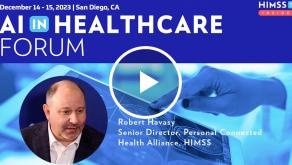2024 will see massive growth in generative AI – but also more regulation

Dr. Justin Norden, a partner at GSR Ventures
Photo: Dr. Justin Norden
Generative AI exploded onto the scene a year ago with the massive popularity of OpenAI's ChatGPT, which uses large language models. Most AI experts believe the technology has endless applications in healthcare, and many leading health systems are already putting it to work.
Dr. Justin Norden, a partner at GSR Ventures, believes 2024 is going to have echoes of 2023 regarding generative AI: more growth, more use cases, more early adopters. But he sees some guardrails emerging too.
We interviewed him to get his views on the year ahead for genAI use, regulation, vendor consolidation and more.
Q. In 2024, you see continued massive growth for generative AI in healthcare. Please discuss why you believe this will continue.
A. While 2023 was filled with hype and discussion around generative AI, few health systems had developed definitive strategies for the emerging technology, and even fewer implemented applications outside of isolated pilot projects with highly targeted use cases.
Most health systems, as is common in healthcare technology adoption, are playing the wait-and-watch game before taking the first step. For example, health systems will likely monitor their peers’ actions and those of the largest vendors in the industry until they feel safe enough to dive in.
The few early provider adopters, however, will start to see clear benefits from their implementation of generative AI applications. Primarily, early ROI will be felt in areas such as ambient documentation, data solutions, revenue cycle management and other administrative tasks that are predominantly lower risk.
Although slower than some other industries, healthcare’s interest in generative AI is astonishing given that it has not even been one year since the launch of ChatGPT by OpenAI. The pace of innovation inside and outside of healthcare in this past year has also been astounding, and I expect it will continue in 2024.
Health systems that are thoughtful about the right infrastructure and use cases will start to see benefits accrue and accelerate in the coming year as the technology progresses.
Q. You say regulation is coming for all types of AI across a broader set of algorithms. Please describe what you think is on the way.
A. A speed bump in front of healthcare’s adoption of generative AI is a lack of regulatory guidance or standardization designed to protect both patient safety and provider liability risk. President Biden’s Executive Order in October to regulate AI is an obvious portend that 2024 will include some sort of federal guidelines and/or legislation.
Regulation of AI, however, was inevitable given its power and the speed of development. To put it another way, it’s currently the Wild West for healthcare AI with thousands of point solutions available, most of which have very limited to no real-world testing and few guardrails around them. This exciting but risky stage is coming to an end.
Specifically in 2024, I anticipate we will see expanded regulation around the use of AI for both clinical and non-clinical healthcare tasks. AI systems will need to be tested for bias, accuracy and safety both before deployment and on an ongoing basis.
Given the continued uncertainty around regulation, health systems will have to be thoughtful about how they comply – even anticipate the government’s final rulings before they are issued. That means provider organizations may have to essentially regulate their own AI algorithms and related vendors.
Q. And beyond AI, you suggest health systems are going to look to consolidate technology vendors because of financial pressures. What do you feel this will look like?
A. Health IT budgets have swelled in recent years, especially due to EHR system rip-and-replacements, as well as the implementation of telehealth and remote patient monitoring systems during COVID-19. Not only have these new systems required more vendors and more cost, health systems have had to hire more high-paid IT staff and consultants to manage and reduce technology and workflow complexity.
This exponential IT budget growth trend cannot continue.
The financial pressure that hospitals have felt most acutely since 2020 will persist in 2024, forcing organizations to consolidate health IT vendors – starting with systems that have not demonstrated a definitive ROI or provide critical infrastructure. So-called "nice-to-have" and other convenience solutions will be removed and the pressure will be placed on vendors of core platforms to deliver more value.
In this climate, selling new IT into hospitals will be even more challenging, but vendors can compete by demonstrating clear and referenceable ROI.
For example, end-to-end system vendors can show potential customers how implementing their solution will enable hospitals to eliminate disparate, disconnected applications that frustrate providers and add complexity to the IT infrastructure. A seamless, integrated system that has real-world evidence of reducing clinician burden and IT overhead can be a persuasive business development strategy.
Follow Bill's HIT coverage on LinkedIn: Bill Siwicki
Email him: bsiwicki@himss.org
Healthcare IT News is a HIMSS Media publication.
























